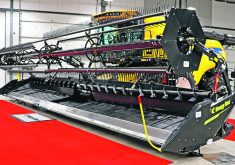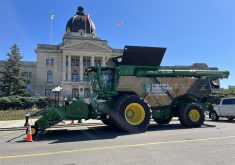A new bin that acts like an implement puts 10,000 bushels of portable, hopper bottomed space into place, when needed
REGINA — A 10,000-bushel, portable grain bin was first shown to the public at Canada’s Farm Show in Regina last week.
The T-Bin, developed by AgMinded Research and Development, has hydraulic motors that power its telescoping function and a transport system that attaches to the hopper’s base to quickly move the bin when needed.
Pat Beaujot was retired from his role as a founding member of Seed Hawk but then his friend, David Kosior, had an idea for this bin brought Beaujot back into the equipment manufacturing business.
Kosior had been involved with grain bin moving and he saw the need for a system that can handle the harvest surge but can also be quickly and safely moved to support different areas for larger farms.
Beaujot said he believes there are many farms that would benefit from mobile grain storage system.
“We started working on this about three years ago, and we finally came up with a concept of how to actually make it telescope and to make a hopper bin on the bottom to lock on at the top,” Beaujot said.
The bottom of the bin is basically a standard hopper bottom bin with a heavy steel ring around the bottom made with corrugated metal.
To lift the telescoping section of the T-Bin, a series of hydraulic motors mounted on the reinforced skid turn sprockets that move chains that pull the top section up.
The T-Bin has a tarp roof, and an inner bin with arms that fold in and out.
“The steel ring on the bottom of the upper bin has a 45-degree angle piece of steel welded all the way around it. And so basically what happens is when you lift that outside bin the folding arms fold out a little bit and locks on and seals,” Beaujot said.
“That upper bin is locked right on there and it can’t move.”
There is also curved sheet metal on the outside of the seals to help support this mechanism.
Users of the bin will need to anchor it down just like traditional hopper bins.
“It has a tarp roof that kind of comes down flat and then the outer bin drops down right to the base of the hopper bin and then it becomes 17 feet high,” Beaujot said.
“It has its own wheels, and it’s 27-feet wide for transport, which is exactly the size of an 84-foot Seed Hawk.”

When expanded into storage mode the bin is 36 feet tall.
The dolly system that moves the bin uses an engine and hydraulic system to lift the front and back of the bin.
However, farmers can also use the hydraulics on their tractors to lift the bin.
“We shipped it here all the way from Brandon (to Regina) on its own wheels. So, it’s a good heavy system. We’ve made it so it can handle the traffic and it can transport quite well,” Beaujot said.
He said the bins provide logistic flexibility that enable farms to match their storage capacity to the crops grown in a specific area of a farm.
“If you put your bin yard and an old yard site that has power you can even have aeration. So, we think it’s a good alternative for farmers when the value of the crop is so high, it’s best to put it in a very safe storage place,” Beaujot said.
The T-bin will retail at about double the cost of a conventional 10,000-bushel hopper bin.
The dolly system can be used for multiple bins, and there may be an opportunity for farms in an area to share a system, or for a custom business to move the bins around.
















